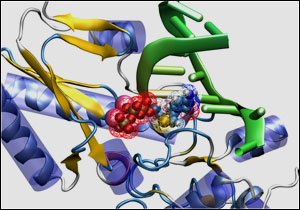
Lamivudine complexes with nucleic acids
(green) in HBV polymerase model
Definition:
- Hepatitis B (HBV) is a serious public health challenge. The World Health Organisation (WHO) estimates that more than 360 million people worldwide are chronically infected with HBV
- Those with chronic hepatitis B (CH-B) are at risk of cirrhosis of the liver (30%) and liver cancer (5-10%). About 70 million new cases of CH-B are reported worldwide each year
- Like the cause of many infectious diseases, HBV mutates in response to drug treatments
- As the number of medications available to treat the disease grows, so to do the number of mutations, which increase in response to each new treatment
- These mutations can lead to drug resistance, cross-drug resistance and multi-drug resistance, presenting an increasingly complex web of challenges for physicians seeking to identify the correct medication for a patient at a particular time
- The majority of patients with CH-B will require long-term antiviral therapy and this often results in the emergence of drug resistance
- Primary antiviral treatment failure (or non response) is classified as the inability of the antiviral agent to reduce HBV DNA viral load by greater than or equal to 1 log10 IU/ml within the first 3 months of treatment
- Secondary antiviral treatment failure, which is usually associated with drug resistance, is defined as a greater than or equal to 1 log10 IU/ml increase in viral load from nadir in two consecutive samples 1 month apart in patients who initially responded
- Antiviral drug resistance now poses a major problem for the management of patients with chronic hepatitis B and is the major reason for treatment failure
- Antiviral drug-resistance reflects the reduced susceptibility of a virus to the inhibitory effect of a drug
- Antiviral drug resistance results from a process of adaptive mutations under therapy. It is due to:
- high HBV replication rates
- low fidelity of the viral polymerase
- selective pressure of the drug
- genetic barrier of the drug
- role of replication space (liver turnover)
- fitness of resistant mutant
- Emergence of drug resistance in those treated patients with CH-B generally results in progression of liver disease and in some cases, significant clinical deterioration if hepatic reserve is compromised.
All material copyright Evivar Medical Pty. Ltd. All rights reserved